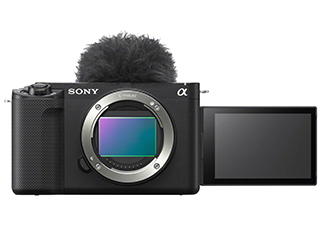Every
year we have made it a point to tell our readers, the direction in
which the photographic industry is heading. The trends article
started as a one off in our earlier issue and with time has become an
annual feature in the magazine that the readers have admired a lot.
So once again it is the start of another year and here is our trends
issue. As mentioned before, this article is more than what meets the
eye. For many it might see as if it is random styles, technology and
trends put together. But the points mentioned below culminate after a
lot of thought, internal debate and also the future. So these are the
trends that we feel will become big in the industry in the year 2020.
End
of the DSLR, its Mirrorless time
.jpg)
This
point has already featured in the last 2 editions of this article but
the importance of this is going to be the greatest in this year. For
the simple reason that the only two primary manufacturers that are
still in the DSLR business have also almost entirely shifted to
mirrorless. Canon is the only brand in 2019 that launched a DSLR,
with its EOS 90D. All models introduced by Nikon were in the
mirrorless category. Of course, Canon is rumoured to be working on a
professional camera which mostly likely might launch at CP+ this
year. And Nikon will also probably have some product in that
category. But largely all the other manufacturers are now in the
mirrorless game and 2020 probably might see the last of these models
being launched.
Film
photography
When
I had spoken about this point a few years back in one of the
articles, Film was showing some minuscule signs of resurgence. But
thanks to the power of social media filters, the film community has
nearly doubled in the past few years. And this is evident with the
continual release of film products launched by a variety of
manufacturers.
.jpg)
For
instance, Fujifilm has released its famed ACROS II film in Japan in
December 2019 and Kodak also released its Ektachrome
E100 film in
4×5 sheets and 120 medium format film with the 35mm rolls already
available for some time now. Ilford is also another manufacturers
that has been continually manufacturing film for professionals. This
only means that the consumers of these products are only increasing.
Mirrorless
lenses
Although
this pretty much is a no brainer, with the popularity of the
mirrorless format, lenses have played a very important role in its
popularity. And although most manufacturers started slow, their
growing portfolio of lenses and development is a testament of their
commitment to the format. However we still haven’t seen some of the
best focal lengths making it to the category. But this is changing
fast. Manufacturers are already in the midst of launching/developing
popular lenses in the mirrorless format so that the users can make
the most out of their photography.
.jpg)
Cloud
storage and other formats
With
the increase in the megapixels and videos capturing capabilities of
cameras, storage is one of the key areas that has needed importance.
The requirement of faster cards, compact drives and lesser clogging
of your internal memory has given the rise to Cloud Storage and other
formats. And moving forward these services will only become more
popular with more and more primary technology manufacturers also
offering competitive prices for cloud storage.
.jpg)
And
manufactures like WD and SanDisk are introducing portable SSD
solutions like SanDisk Extreme Pro SSD that are targeted towards
photographers offering high transfers speeds and compact/portable
solutions.
Synergy
between apps and cameras
With
smart devices practically taking over our daily lives, 2020 will see
a lot more synergy between apps and cameras. Most manufacturers
already have apps that are available to transfer and control the
basic settings of your cameras since the past few years. But lets be
honest, the user interface of these apps aren’t that great and
neither do they have the advanced features that they could.
.jpg)
With
the UI of the cameras improving continuously, it is only a matter of
time that apps also will become good and this year will see a lot of
that happening.
Pop
goes the colour
When
it comes to photography styles, let’s face it, we aren’t really
having any breath taking/sky tearing innovations. And to be fair
there is only so much that a photographer can think of. Over the
year’s styles tend of re-emerge with certain modifications and
‘Loud Colours’ is a trend that we predict will be big in 2020.
.jpg)
And
this will be all around, when it comes to shoots, weddings, pictures,
ambiance, clothes and the works. So get ready to see those colours
pop in 2020.
Quick
assembled accessories and battery powered lights
One
of the most difficult categories to predict are accessories. For the
simple reason that it is a fast-changing environment with any product
suddenly gaining popularity overnight and disappearing overnight. But
2020 will see the popularity of quickly assembled accessories rise
phenomenally.
.jpg)
And
closer to the lights, which play a very important role in
photography, will see battery powered lights becoming very popular.
Manufacturers are already offering such solutions today and the move
is not only environment friendly but also to offer solutions with
better technology and performance.
Vertical
photos and videos (For full screen status updates)
Until
recently taking videos in the vertical format was a taboo and frowned
upon. Even photos in that orientation would not be preferred with
lesser content squeezed into the frame. But the end of 2019 and the
beginning of 2020 has already seen an upward trend of the vertical
format. Status updates, videos and pictures in this format have taken
social media platforms like WhatsApp, YouTube and Instagram by storm.
And if that popularity is anything to go by then it is surely here to
stay.
.jpg)
Videos
are taking over Photos
The
popularity of the vertical format bring me to my next point, and that
is Videos are literally taking over. Thanks to Instagram, YouTube and
a certain Tik Tok, the consumption of video content is outweighing
that of the pictures. And this is evident with the abundant features
that are offered with the cameras these days.
First
reaction pictures in Wedding
Capturing
emotions and the mood of weddings has always been important. But
there is a trend that is likely to be very popular in the coming
year, which is ‘First Reactions’. The style includes capturing
the first reactions of the couple, family and friends during the
wedding festivities. This could be the groom seeing the bride the
first time, friends seeing the newly wedded couple the first time or
family controlling their emotions on realisation that their daughter
is now married.
There are
dedicated photographers during weddings to only capture these moments
since they are natural, important and memories that make the big day
special. And this is a trend that will see a lot of the wedding
industry adapting this year.
Environmental
issues or Social Causes
With the social
media now pumping news articles and news stories on their feed, the
younger generation of readers are consuming news online. This has
led to a growing base of youngsters who are aware of the social and
cultural causes across genres. Be it human rights, be it natural and
environmental issues caused due to global warming – photographers
are increasingly focussing on these issues so that people online can
not only read about it but see the impact that human beings have had
on the environment or on other people. This trend of
photographers bringing the issues to the forefront will take center
stage in 2020, given the state of the political and social condition
of the world, photography projects on environmental issues or social
causes will be the main discource this coming year.
.jpg)
Take
me with you (Follow Me) photos
Follow me or take
me with you photos grew in popularity in 2019 as Instagrammers and
Facebook users started using hashtags on the same. The wave of
Follow me photos will continue to rise. For the unnitiated, Follow
me photos are photographs where the subject is holding the
photographer’s hand and the photograph is taken from the
photographer’s point of view. These photos are a great way of
showcasing a destination or a location and will continue to trend in
2020.
.jpg)



.jpg)
.jpg)
.jpg)
.jpg)
.jpg)
.jpg)
.jpg)
.jpg)
.jpg)
.jpg)